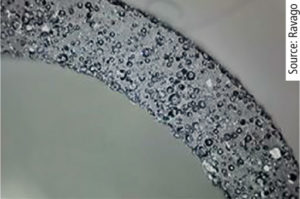Demand for lightweight materials in the automotive, aerospace, construction, and other related industries has increased significantly in recent years due to environmental concerns, government regulations and consumer demand. The major source of weight reduction so far has come from metal replacement but these opportunities are becoming increasingly uncommon. As a result industries are looking for new approaches to light weighting, acknowledging that many small reductions on individual components can amount to a large overall reduction. The thermoplastic elastomer industry has so far focused around foaming as the solution to light weighting but there are four main approaches which, when combined across suitable applications, can offer not only weight reduction but also cost savings and mechanical benefits. Ravago is exploring these options to modify the current Ensoft, Enflex, and Ezprene ranges to create the new range Ravalight.

Foamed compounds
There are two main technologies for foaming, chemical and physical. Combining different technologies makes it possible to achieve density levels as low as 0,3 g/cm3. The benefits of the technology include:
- No requirement for expensive capital investment as it can be used on existing machinery.
- Reduced pressures required mean reduced running costs and lower clamp forces can enable moulders to use smaller machines.
- Ability to fill difficult moulds or dies as the foam expands into hard-to-fill regions that otherwise could have exhibited sink marks or voids.
- Reduced cycle time due to quicker cooling
- Good haptic properties
- The recovery ratio achievable is less than 40 % using this approach according to CS norms.

Glass bubble reinforced compounds
New material destined to revolutionise the weight reduction plans of car manufacturers. Glass bubbles not only reduce the density compared to other glass filled grades but also reduce shrinkage and reduce cycle time. The market is not only demanding light weighting but also materials using renewable resources. Ravago have been able to combine the two.
 Nanoclay reinforced compounds
Nanoclay reinforced compounds
The main filler used in TPE is talc but replacing this with nanoclay can reduce the density while maintaining, or improving, mechanical properties and still offering a cost saving. Nanoclays have also been found to improve chemical, flame and scratch resistance.
Natural fibre reinforced compounds
Another option to replace talc is natural fibre which has a significant density advantage over talc while maintaining the majority of the mechanical parameters. Natural fibres also give the application a tangible eco-friendly credential.
